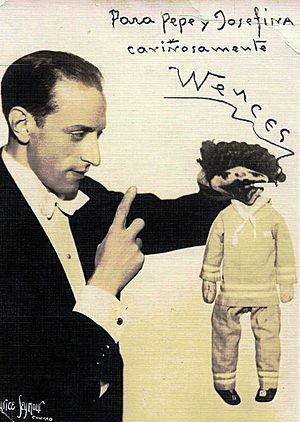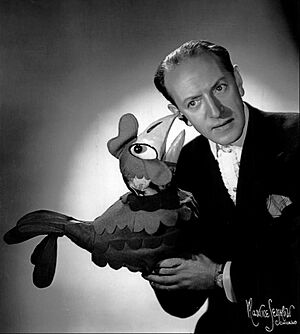Señor Wences facts for kids
Señor Wences (born Wenceslao Moreno on April 17, 1896 – died April 20, 1999) was a famous Spanish ventriloquist and comedian. A ventriloquist is someone who can make their voice seem to come from somewhere else, like a puppet. Señor Wences became very popular in the 1950s and 1960s because he appeared many times on a TV show called The Ed Sullivan Show.
Contents
Early Life of Señor Wences
Wenceslao Moreno was born in Peñaranda de Bracamonte, Salamanca, Spain. When he was 15 years old, he became a bullfighter. However, he had to stop this sport after he got a serious injury.
Doctors told him to exercise his injured arm. So, he learned how to juggle and joined a circus act with some friends. This was the start of his amazing career in entertainment.
Señor Wences's Amazing Career
Performing as "Señor Wences," Moreno was known for how fast and skilled he was as a ventriloquist. He made his puppets seem like real people talking back to him.
Johnny: The Hand Puppet
One of his most famous characters was Johnny. Johnny was just a face drawn on Señor Wences's hand. He would put his hand on top of a small, headless doll.
Señor Wences would talk to Johnny, quickly switching between Johnny's high-pitched voice and his own. He would draw Johnny's face right on stage. He used his thumb and first finger to make the lips. He even used lipstick and a tiny wig!
The idea for Johnny came from his school days. His teacher punished him for imitating classmates. He got ink on his hand and saw a face when he made a fist.
Pedro: The Head in a Box
Another popular character was Pedro. Pedro was a grumpy-voiced head that lived in a box. Señor Wences had to create Pedro suddenly. This happened when his usual, full-sized dummy was broken in a train accident in 1936.
Pedro would speak from inside the closed box. Or, he would say "s'awright" (which means "it's all right") when Wences opened the box. A big part of the fun was how quickly Wences and his puppets would talk back and forth. Their voices were also very different.
More Ventriloquist Tricks
Señor Wences could also throw his voice while his mouth was busy. He might be smoking or drinking, but his puppet would still "talk."
He often used a telephone in his act. He would play both sides of a phone call. For the "caller," he made his voice sound like it was coming through a phone. This voice always started by shouting "Moreno?" (Señor Wences's real last name). He would then reply, "No, Moreno is not here."
He usually ended his show with a big finale. This combined his ventriloquism with juggling and plate-spinning. While he did these tricks, Pedro and Johnny would playfully tease him.
Television and Stage Appearances
Even though he was famous worldwide, Señor Wences spent most of his career in the United States. He arrived there in 1934 or 1935.
He performed live in nightclubs and appeared often on TV variety shows. He was a guest on The Ed Sullivan Show an amazing 48 times! He also performed on Broadway and in Las Vegas casinos.
Later in his career, a new generation of fans met him on The Muppet Show. His very last TV appearance was on The Very Best of the Ed Sullivan Show #2. In this show, he talked about "Suliban" and did a short ventriloquism act.
Pronouncing His Name
Señor Wences pronounced his name the traditional Spanish way. In English, it sounds like "WEN-thess."
After Ed Sullivan would say his name as "Señor Wen-sess," Wences would gently correct him. He would announce himself to the audience by saying: "Hello, I am Señor Wen-thess."
Later Appearances
In the early 1980s, Señor Wences and Johnny appeared in a TV commercial for a Honda car dealer. Pedro's "s'awright" came from the car's glovebox! Johnny would say "Ees Standard" and "Nice!" about the car's features.
In 1986, he was a guest on It's Garry Shandling's Show. In 2009, Señor Wences was featured in a comedy documentary called I'm No Dummy.
Señor Wences's Famous Phrases
Señor Wences had some very funny phrases that his audiences loved.
One of his most famous bits involved a low voice coming from inside a box. He would shout, "Hello in the box!" At the end of their chat, he would open the box and ask, "S'aright?" (meaning "It's all right?"). The voice from the box would answer, "S'ariiight!" Then, Señor Wences would quickly shut the box again.
Another popular phrase involved his hand puppet, Johnny. Wences would explain that something was easy to do. Johnny would then reply in his Spanish accent, "Easy for you, for me ees very deefeecult!"
These phrases were so popular that Señor Wences even released a record in 1959. It featured songs like "S-All Right? S-All Right" and "Deefeecult For You—Easy For Me."
Legacy and Passing
Señor Wences received a special award called the Lifetime Achievement Award from the US National Comedy Hall of Fame in 1996. This was a great honor for his long career.
Even after he retired at 100 years old, his famous puppets, Johnny and Pedro, "kept working." Other ventriloquists performed at his 100th birthday party.
Señor Wences passed away on April 20, 1999, just three days after his 103rd birthday. He lived in New York City, very close to the Ed Sullivan Theater. The section of 54th Street where he lived has even been named "Señor Wences Way" in his honor. His picture can be seen at The Players Club in New York.
Images for kids
See also
 In Spanish: Señor Wences para niños
In Spanish: Señor Wences para niños




